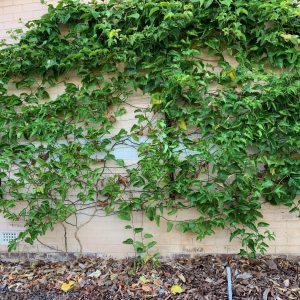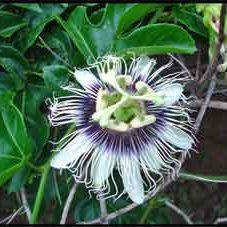Passiflora edulis
Passionfruit, granadilla
Origin
Native to southern Brazil. There are two basic forms, P. edulis (purple passionfruit, PP) and P. edulis f flavicarpa (yellow, YP), and from these many hybrids have been produced.
Climate
They grow well in sub-tropical and in elevated tropical areas where temperatures are not too low; YP is the more tropical of the two. Precipitation of 750-1250mm pa is best; if not well-distributed then irrigation will be required to sustain soil moisture and vegetative growth and production. Ideal temperatures are 20-25°C and tolerance of drought and frosts is low.
Plant Description
Passionfruit are hexaploid, vigorous perennial herbaceous or woody vines up to 15m long, usually with axillary tendrils. The large tri-lobed alternate leaves have serrate margins. PP and YP have unbranched green and red-purplish tendrils respectively. They are not long-lived plants, with maximal production of PP for only 3-4 years.
Relatives
Passifloraceae Family. Passiflora is a genus of about 500 species of flowering plants, many of which have beautiful, ornamental flowers. Only about a dozen species produce edible fruits, including Banana Passionfruit, Giant Granadilla and Sweet Granadilla.
Soils
Fertile soils, pH 5-5-6.8, that are well-drained with high moisture retention are best. However, they can tolerate a widerange of soil types. Mulching in sandy soils assists retention of water and nutrients.
Propagation
Easily done with seeds, cuttings, air-layers and by grafting. However, as many superior passionfruit cultivars are hybrids, their seedlings will have variable characteristics compared to the parent, so named cultivars are best propagated vegetatively. Seedling YP are widely used as rootstocks in grafted plants as they are vigorous and resistant to root and stem rots and nematodes.
Cultivars
Some cvs that can be sourced here are Panama Red, Panama Gold, Sunshine Special, Supersweet, Misty Gem, E-23 and Lacey. Sunshine Special is mainly propagated by cuttings and doesn’t have a suckering problem as with many grafted plants; it also has good fruit set without any need for hand-pollination. The Panama varieties are more suitable for warmer areas north of Perth.
Flowering and Pollination
Single hermaphrodite protandrous flowers can potentially form in each leaf axil. They are showy, 6-9cm diameter, with 5 sepals, 5 white petals forming a tubular calyx surrounded by a thread-like crown in the centre. The five stamens unite as a stalk bearing the superior ovary with 3 horizontal styles. Flowering can occur for much of the year in warm climates. They open in the morning and bees are the main pollinators. The most effective time for pollination is when the styles are curved towards the anthers. Rain at flowering time bursts pollen grains and may also interfere with bee activity. PP and hybrids are self-compatible but YP requires cross-pollination.
Cultivation
They are most productive in full sun but will tolerate some shade. Fertilizers are routinely applied as passionfruit yield is related to growth; it’s one of those species where NPK applications should contain more K than N. Nevertheless, applications should be prudent as too much growth fosters disease. When young, small monthly applications are given with larger, less frequent amounts given as the plant matures. Water stress may cause young fruits to drop.
Wind Tolerance
Windbreaks are important if grown in exposed sites.
Pruning
Vines are supported on trellising of some sort with horizontal leaders giving off many fruiting laterals that hang toward the ground (hanging curtain). When this stage is reached some growers only then prune laterals that may touch the ground, with replanting when the canopy becomes overly dense. Others thin periodically by cutting back laterals to 20cm long, encouraging new lateral growth and flowering.
The Fruit
A many-seeded berry, round to oblong, 5-10cm long, with many brown or black seeds surrounded by juicy and tangy arils. The yellow through to red or black purple skin is smooth and can be paper-thin to 5mm thick. The edible pulp has a fragrant odour and delicate flavour. YP is an excellent source of vitamin A (carotenoids) and both forms contain 11-15% carbohydrates.
Fruit Production and Harvesting
Fruit mature in 3-4 months depending on climate. Commercial fruit are picked but home growers can wait for fruit to fall, with regular collection to prevent spoilage. Fresh YP and PP can be stored for 1-2 and 4-5 weeks respectively in a crisper at 5°C.
Fruit Uses
Passionfruit are mostly converted into juice and also eaten fresh. They find widespread use as a flavouring agent in yoghurt, ice-cream and fruit salads and are incorporated in many baked products. They are probably valued more for their unique flavour and aroma than for nutritional content. Yield of juice to fruit ratio is 30-33% and 45-50% for YP and PP respectively.
Pests and Diseases
Possible pests include – Medfly, scales, mealy bug, mites and nematodes; and diseases – septoria, alternata or brown spot, anthracnose, base rot, fusarium wilt, Phytophthora blight, scab and woodiness virus. Birds are occasional pests.
Comments
As fruit is borne on new growth, plants should be kept in an active growth state. The most suitable cvs for our climate are relatively self-fertile, producing heavy crops, but hand-pollination may be necessary for fruit set in others. Plants are not long-lived and the need for replacement should be anticipated.
Be wary of grafted passionfruits that are on P. caerulia rootstock (such as Nelly Kelly): this rootstock is exceedingly invasive, it suckers extensively and is hard to eliminate. Frequently, the graft fails and the rootstock takes over. It is easily recognised by its five-fingered leaf shape.
More Information
Passionfruit – flowering and yield
Passionfruit vines (Passiflora edulis, the purple-skinned fruiting species) are grown by many of our members as they have a short juvenility period, occupy little space when trained against a wall or fence, and can quickly produce lots of desirable fruit that can be eaten fresh, frozen, used as toppings or incorporated into many cooked foods. The yellowskinned variety (Passiflora edulis f flavicarpa) produces bigger fruit and higher yields but is more suited to tropical areas than the sub-tropical conditions in the Perth region. However it is sometimes used as a root stock in grafted plants as it’s more vigorous and has better disease resistance properties. Sunshine Special is a purple variety eminently suited to us here as it’s self-compatible and doesn’t need hand pollination or other varieties for cross-pollination, provided sufficient honeybees (Apis mellifera) are present for pollination. Honeybees are not efficient pollinators but the best we have, and if vines are well managed we can get two main crops per year. Of course we all want to have good yields of large fruit that are full of edible pulp with each cropping season every year (eg Figure 1), but sometimes in a given year one crop may be bounteous with heavy pulp-laden fruit, and the other less so with fewer fruit and/or some that are only partly filled (Figure 2). What’s going on and can we do anything about this variation?
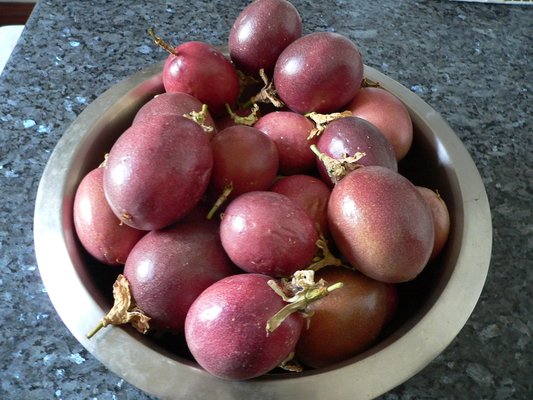
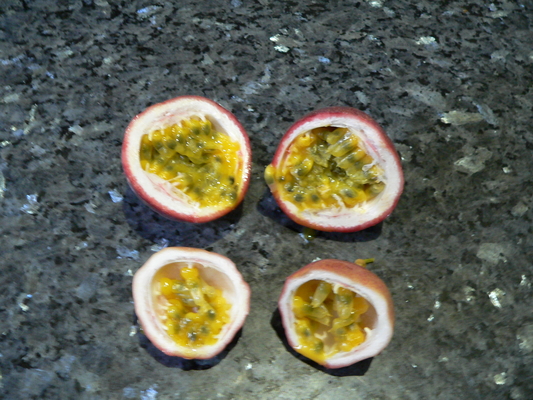
The following commentary considers how honeybee behavior together with flowering morphology and properties can variably impact this issue, not the more general scenario of universally poor yields and quality every year that require the usual management solutions. Regarding irregularity and before considering the influence of flowering behaviour, a number of other important factors should be recognised. Bees are our main pollinators (Figure 3) and use of pesticides for other crops in your garden at flowering time can have a major impact on pollinator numbers and pollination; they’re also less likely to leave their hives with colder weather or rain. Above-canopy irrigation and/ or rain through flowering times causes pollen grains to burst with loss of viability, either while still on the anthers or within two hours of being deposited on stigmas and before germination. Desiccation of the stigma can occur with high temperatures, strong winds and/or low humidity during flowering. Also, if there has been a high crop load in one season the next may be reduced, similar to many other fruiting species (alternate bearing, usually across years but in this case within years), presumably because of decreased nutrient supplies and/or hormonal regulation.
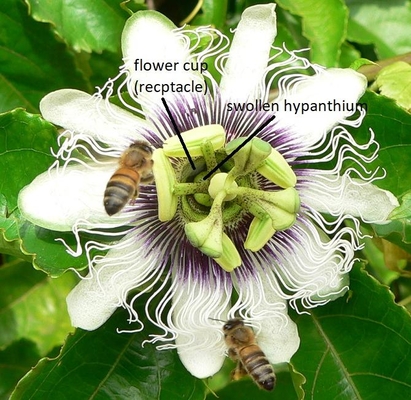
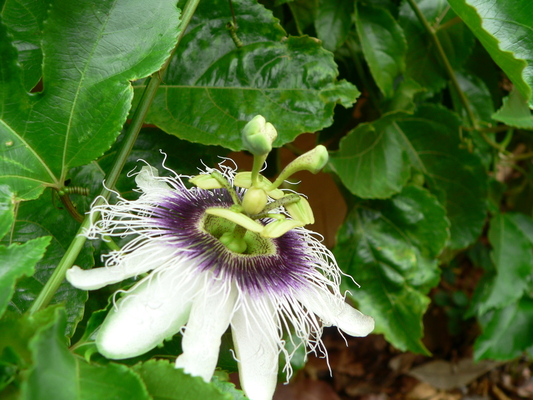
Like other flowering plants, passionfruit have evolved in ways that encourage some cross-pollination to induce hybrid vigour and the means to respond to changing environments over time for survival of the species. In some species, sexual reproduction is complemented by facultative apomixis as a backstop. Individual passionfruit flowers remain open for one day only, although bloom across flowers may continue for several weeks. Flowering is protandrous but the temporal separation is not extreme. Pollen is released early in the morning and a few hours later the stigma becomes receptive, seemingly providing sufficient overlap for effective bee-mediated pollination to occur. As a flower opens, the central styles and stigmas are vertically positioned above the corona, petals and sepals (Figure 4).
The surrounding filaments carrying the anthers also begin in the vertical position, but very quickly move into a horizontal position. Concurrent with this movement the anthers rotate 90° from being aligned with the filaments to become circumferential. The next process a few hours later to facilitate pollination is when the three styles bend downwards (recurve) so that they’re in the same plane and radius as the anthers and in intermediate positions with them (see Figure 5). In some flowers (about 20%) the styles don’t recurve at all or do so only partly, and remain above the anther plane. These two types set very few fruit for two reasons – (i) they’re not close enough for pollen to rub off bees while they’re focussing on collecting pollen further down the flower, and (ii) the stigmas are less receptive.
For honeybees, the first reward they seek with anthesis in the mornings is pollen. Passionfruit flowers produce nectar (mainly sucrose) that honeybees are interested in, but the nectary annulus is located deep in the flower between the receptacle and the central hypanthium and is covered by two lids (operculum and limen, see Figure 6). To access nectar, pollinators have to be small enough to squeeze through this small aperture, or have long enough tongues to be able to access nectar from above the flower cup rim and central hypanthium and be able to push the two lids apart. Honeybees don’t fulfill the first of these criteria (see Figure 3).
The second is only marginally achieved if they spend an inordinate amount of time on a given flower for small amounts of nectar, but their typical behavior is to move to others and seek more pollen. Larger carpenter bees have tongues long enough to reach the nectar from above but normally their numbers in the Perth region are not sufficient to achieve significant pollination. Effective stigma pollination in passionfruit is passive in that honeybees have rubbed against the anthers and picked up some pollen on their hairy bodies throughout the morning. By the time the styles have recurved to be in close alignment with the anthers, some pollen is deposited on stigmas provided they revisit. With three styles and stigmas, the number of fertilized seeds and fruit weight increases with increasing pollination of the number of stigmas. Stigmas are most fertile in the fully recurved position when they secrete sticky fluids that help retain pollen grains, and through dual recognition, facilitate subsequent pollen germination and pollen tube growth towards ovules for fertilisation.
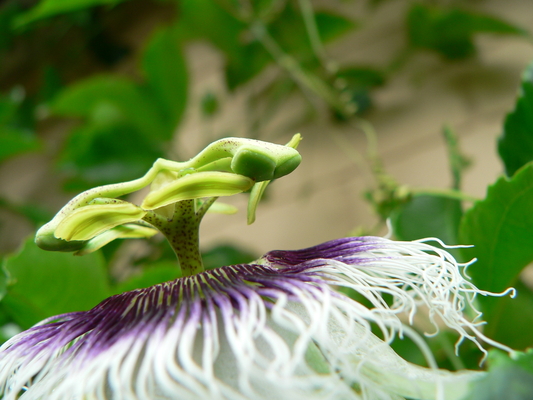
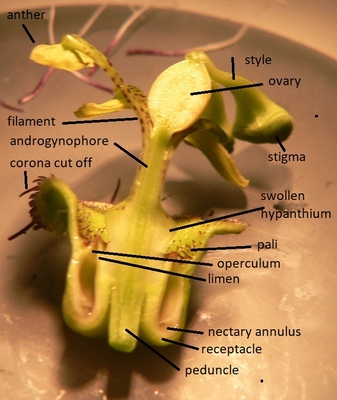
If sunlight and temperatures during bloom in particular seasons and days are conducive to early flower opening and there’s lots of bee activity, they can basically strip anthers of all pollen within a very short time, ie before the styles have recurved and are fully receptive. After stripping, their foraging activity is sophisticated enough that they don’t spend much time re-visiting these flowers, and as a consequence they may be pollinated inadequately or not at all.
Passionfruit flowers require a minimum of about 40 ovules to be fertilised for fruit set, and below this number flowers quickly abscise. Above this level there may be fruit set leading to mature fruit, but unless it’s more than 100 the fruit will be light and only partially filled. You may wish to read a report where this problem of premature honeybee pollen stripping was specifically addressed by using exclusion nets that are removed later each day when styles have fully recurved and are receptive (Israel Journal of Plant Sciences (2009) 57, 243-251, P edulis cv Passion Dream). Obviously this is a costly and time-consuming operation, but after trying several alternatives over a 10 year period it was the only one found effective, producing twice the fruit set of hand pollination with equally sized fruit. If you’re experiencing this problem and have more than one vine, you might be able to help things along by locating them in positions with slightly different micro-climates and sunlight that could alter flowering overlap times and possibly increase effective pollination. Also, individual plants of the same cultivar can still have genetic variations for all sorts of reasons, so with more than one plant (not all derived from cuttings of one plant), there may be a sufficient spread in pollen anthesis for effective overlap with full stigma recurvature across plants. Another point to realise with flower abscission is that individual branches only allow 4-10 fruit to be set; afterwards further flowers will drop even with effective pollination. As fruit mature and there is new vegetative growth on the branch, flowering leading to fruit will then be possible again.
